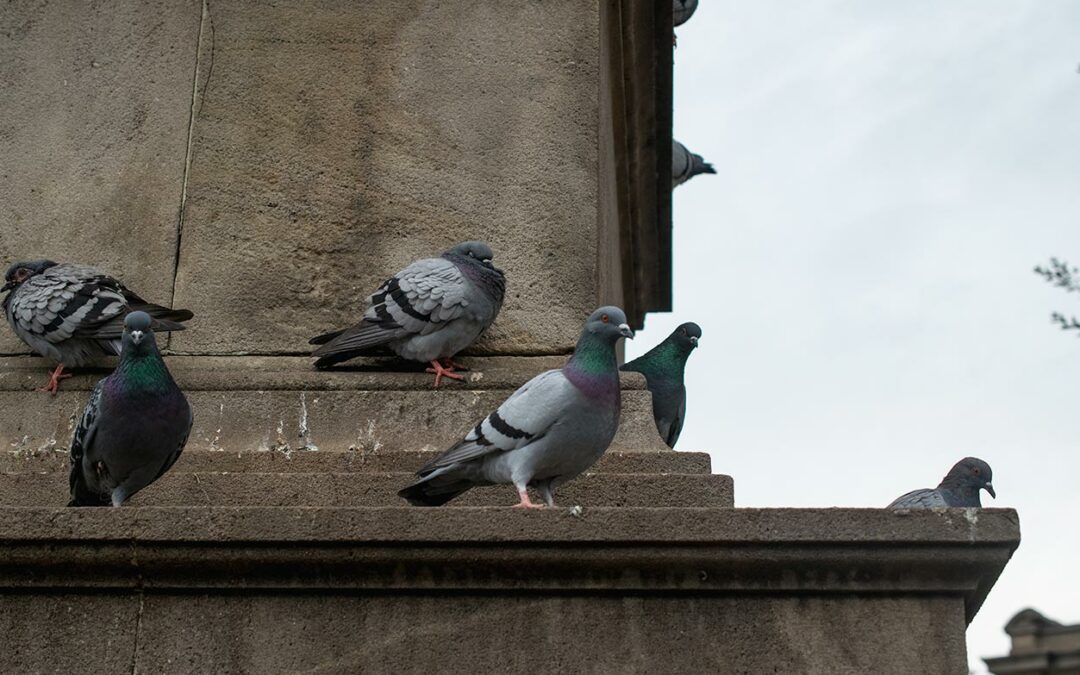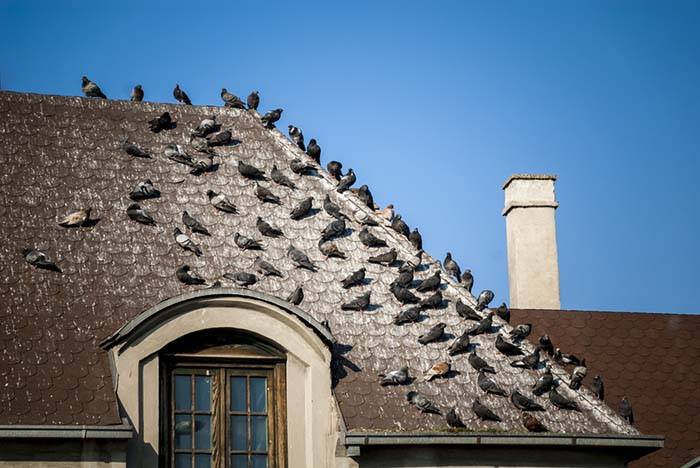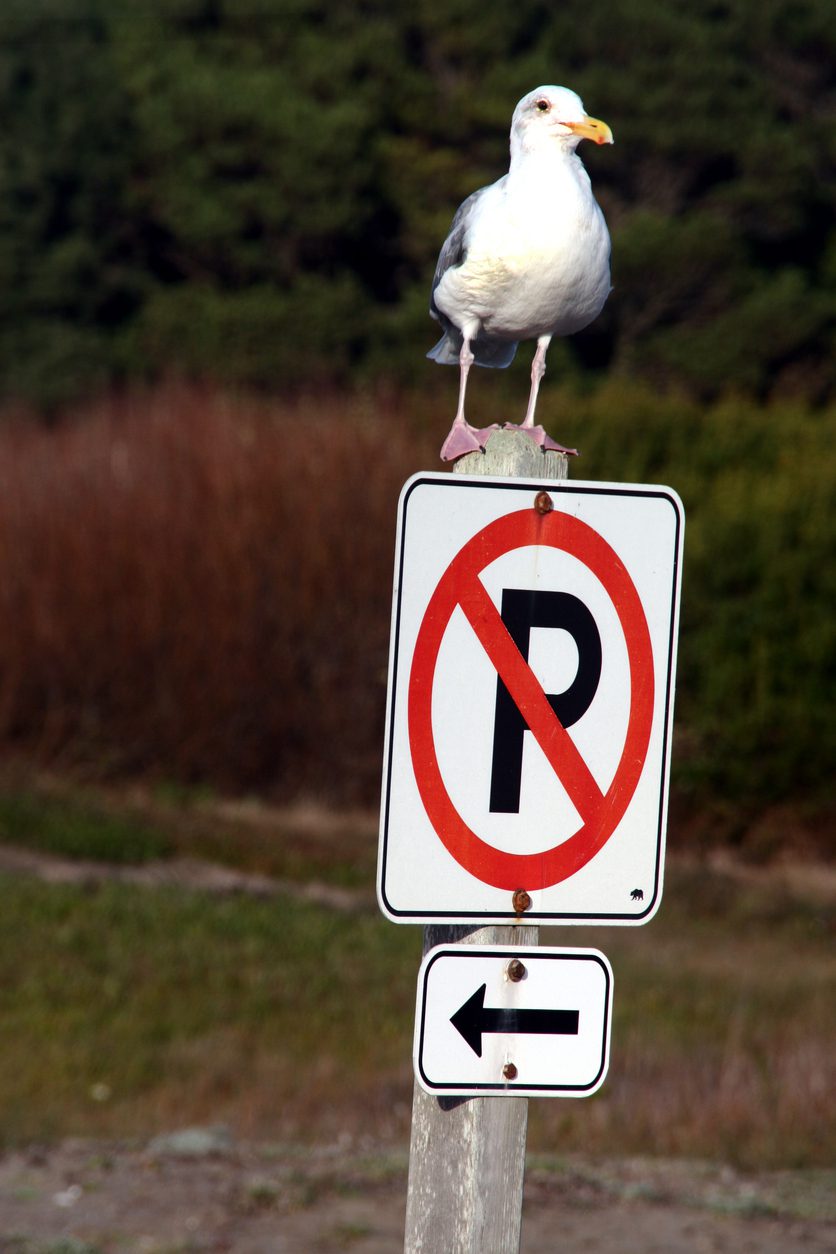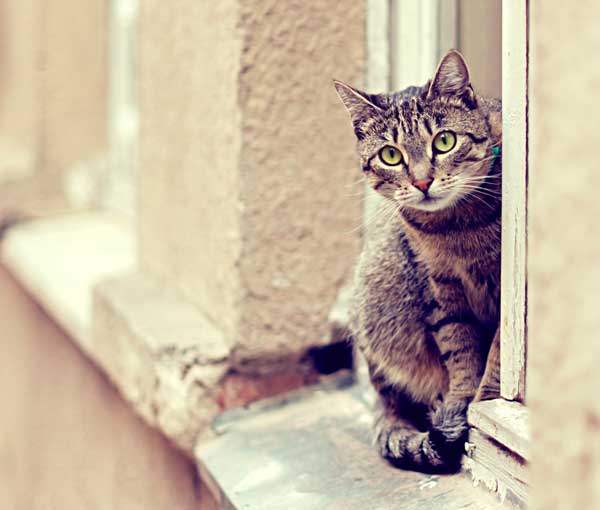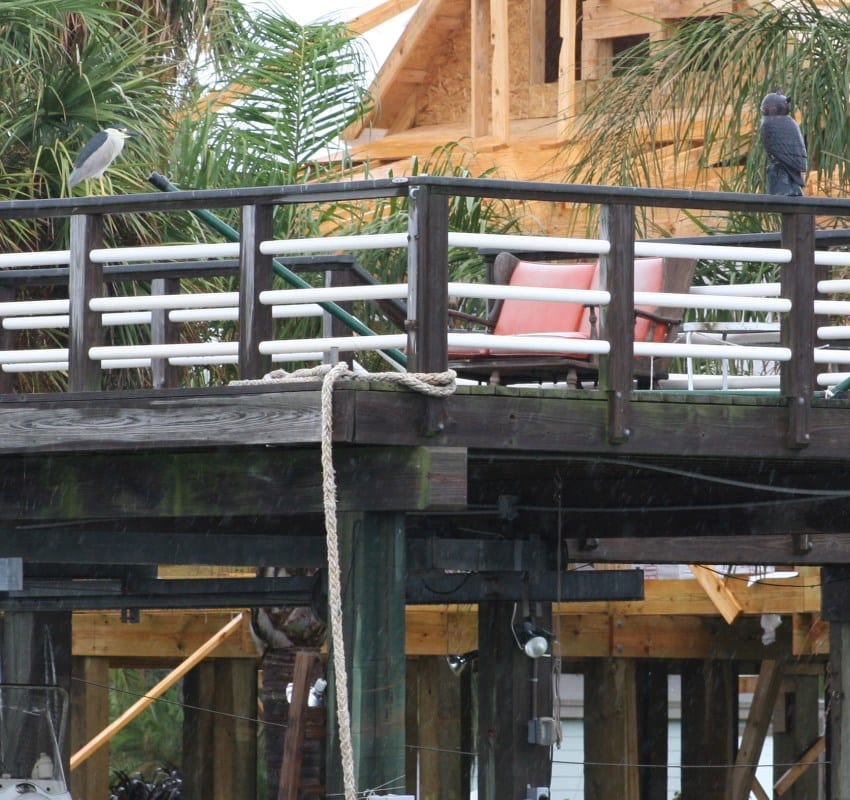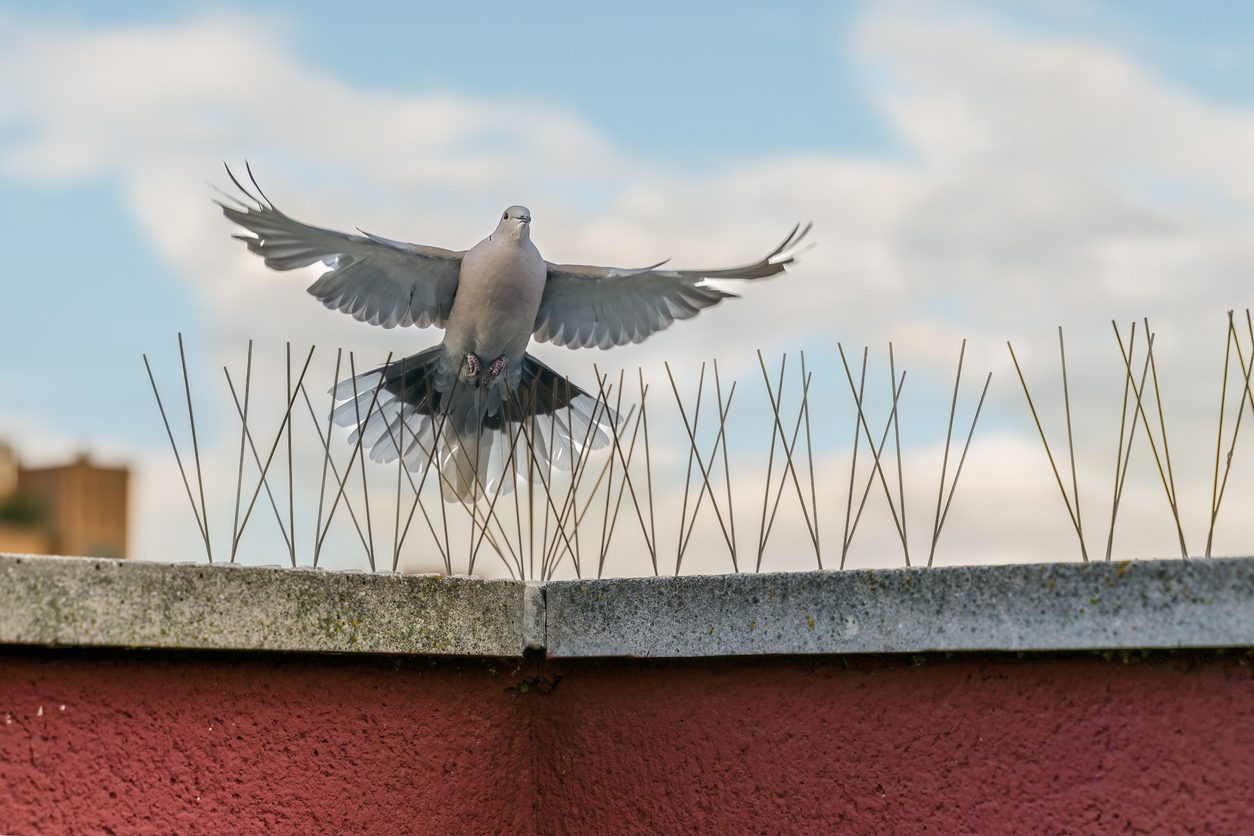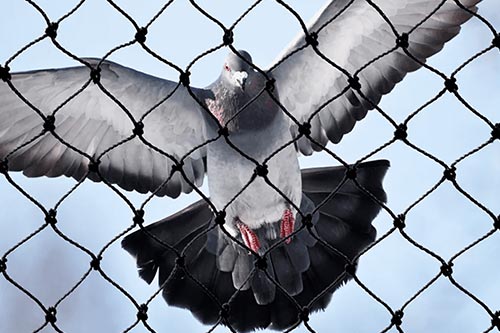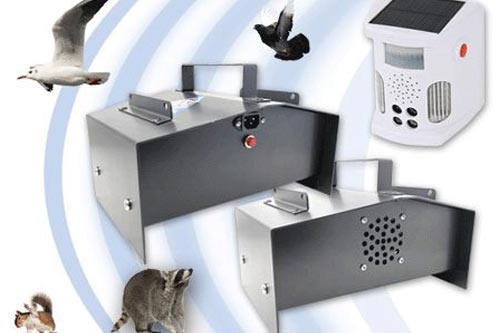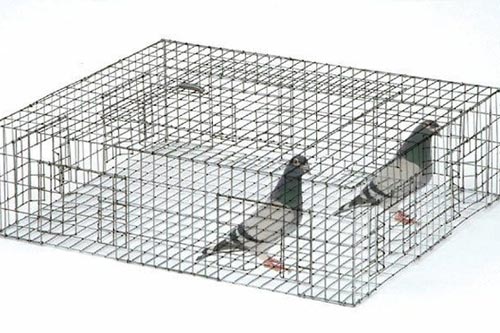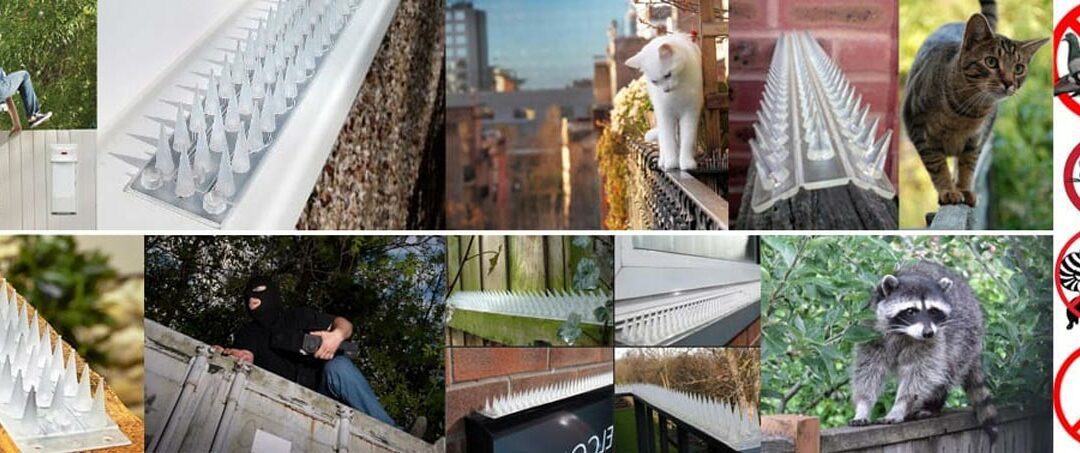
by Pigeon Patrol | Feb 10, 2025 | Animal Deterrent Products, Bird Deterrent Products, Bird Spike, Bird Spikes, Fence Spikes, Pigeon Control, Pigeon Droppings, Pigeon Spikes, Pigeons, Raccoons
Have you noticed pigeons perching on your fence or small animals like raccoons and squirrels climbing over? Fence spikes are an easy, humane, and effective solution to deter unwanted birds and pests.
Fence spikes prevent birds from roosting and make it difficult for animals or intruders to climb fences. They are a non-harmful way to protect your property from nuisance wildlife while adding an extra layer of security.
What Are Fence Spikes?
Fence spikes are thin, pointed strips that can be attached to fences, walls, and ledges to prevent birds and animals from landing or climbing.
They are typically made of:
- Plastic – Lightweight, affordable, and easy to install.
- Metal (Stainless Steel or Aluminum) – More durable, weather-resistant, and suitable for high-security areas.
How Do Fence Spikes Work?
Fence spikes do not injure or harm animals—they simply create an uncomfortable surface that prevents perching, climbing, or trespassing.
Pigeons, for example, prefer flat, stable surfaces to land on. When spikes are in place, they look for another location that is easier to access. Similarly, raccoons and cats will struggle to grip and climb over a fence with spikes.
Why You Need Fence Spikes?
1. Prevent Pigeons and Other Birds from Perching
Birds love to perch on fences, leaving unsightly droppings and making noise. Fence spikes provide a simple and long-term solution to keep them away.
2. Stop Animals from Climbing Over Fences
Fence spikes can deter small animals like:
✅ Raccoons
✅ Squirrels
✅ Cats
✅ Possums
These animals often use fences as pathways to access food sources or nesting areas. With spikes in place, they will move on to another location.
3. Improve Property Security
Fence spikes act as an extra deterrent against intruders by making it difficult to climb over walls or fences. They are often used in:
- Residential homes – Prevent break-ins.
- Commercial properties – Deter trespassers and vandals.
- Industrial sites – Protect equipment and supplies.
4. Weatherproof and Long-Lasting
Most fence spikes are made from durable materials like stainless steel or high-quality plastic. They can withstand:
☀️ Sun exposure
🌧️ Rain and snow
💨 Strong winds
Once installed, they require little to no maintenance.
Best Places to Install Fence Spikes
1. Residential Fences
Keep birds and small animals off wooden, vinyl, and metal fences around your home. This is especially useful if you have:
🏡 A garden – Protect plants from birds and animals.
🐾 Pets – Prevent raccoons from entering your yard.
2. Commercial Property Fences
Fence spikes are often installed on business properties to prevent:
🏢 Vandalism and trespassing
🚛 Theft from storage yards
3. Walls and Ledges
Pigeons love to perch on high walls and ledges. Installing spikes in these areas will keep them away for good.
4. Garage Roofs and Sheds
Garage roofs are common resting spots for pigeons. Prevent them from nesting by adding fence spikes to the edges.
How to Install Fence Spikes
Step 1: Choose the Right Type of Spikes
- Plastic spikes are best for residential fences and areas with low security concerns.
- Metal spikes are ideal for high-security zones, commercial properties, and industrial sites.
Step 2: Clean the Installation Surface
Remove any dirt, bird droppings, or debris before installation. This ensures a strong bond with the surface.
Step 3: Measure and Cut Spikes to Fit
Use scissors or wire cutters to trim spikes to the required length.
Step 4: Attach the Spikes Securely
You can secure fence spikes using:
🔹 Adhesive – Best for plastic spikes and temporary installations.
🔹 Screws or nails – Provides a more permanent and weather-resistant installation.
Step 5: Inspect for Gaps
Ensure there are no spaces where birds or animals can still land or climb through.
Maintenance Tips for Fence Spikes
🛠️ Check spikes regularly for wear and tear.
🧽 Remove debris and dust that may collect over time.
🌦️ Inspect after storms to ensure they are still securely in place.
Once installed, fence spikes require little upkeep and remain effective for years.
Do fence spikes hurt birds or animals?
No! Fence spikes are designed to make surfaces uncomfortable, not to injure. Birds and animals will simply choose another location.
Can fence spikes be installed on all types of fences?
Yes! Fence spikes work on wood, vinyl, metal, concrete, and brick fences.
Are metal spikes better than plastic ones?
Metal spikes are more durable and weather-resistant, while plastic spikes are cheaper and easier to install.
How long do fence spikes last?
High-quality spikes can last 5-10 years or more with proper installation.
Where can I buy high-quality fence spikes?
Find durable and affordable fence spikes at Pigeon Patrol.
Fence spikes are a simple, effective, and humane way to prevent pigeons, small animals, and intruders from accessing your property. Whether you’re looking to protect your fence, deter climbing animals, or enhance security, fence spikes are a cost-effective solution.
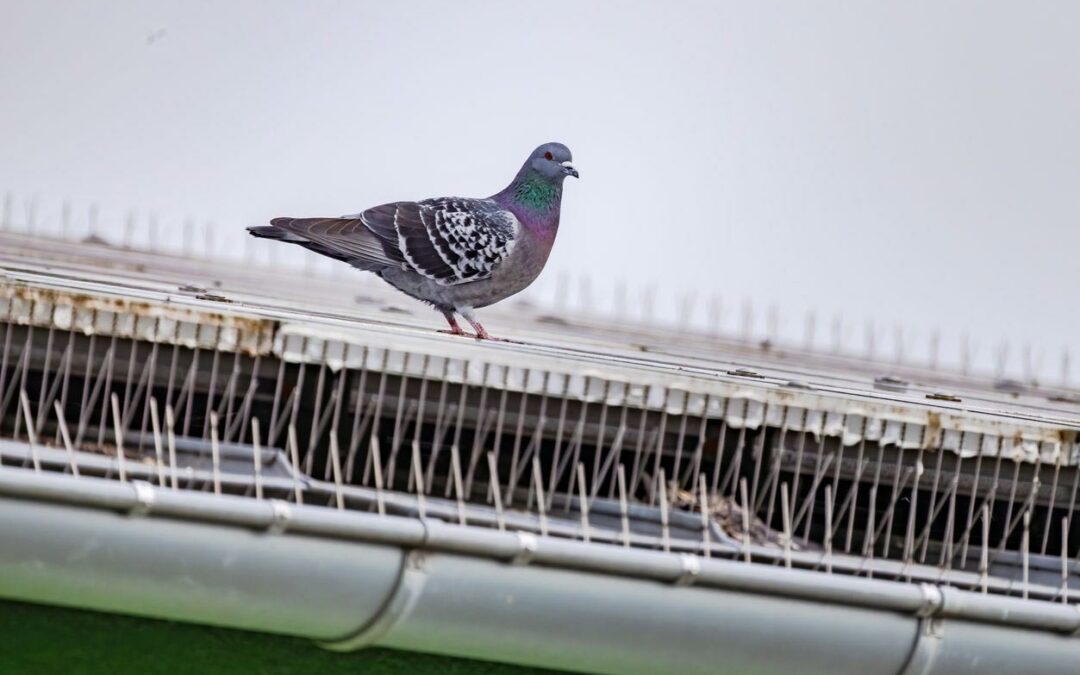
by Pigeon Patrol | Feb 10, 2025 | Animal Deterrent Products, Bird Deterrent Products, Bird Spike, Bird Spikes, Pigeon Control, Pigeon Droppings, Pigeon Spikes, Pigeons, Raccoons
Pigeons are notorious for perching, roosting, and making a mess on buildings, ledges, and signs. If you’re tired of constantly cleaning up pigeon droppings or dealing with unwanted birds, pigeon spikes are one of the best long-term solutions.
Pigeon spikes are a safe, humane, and highly effective method to prevent birds from landing in specific areas. Unlike harmful methods, spikes don’t injure birds; they simply make it uncomfortable for them to perch.
What Are Pigeon Spikes?
Pigeon spikes are narrow strips with upward-pointing rods that make it physically impossible for birds to land. They can be made of:
- Stainless steel – Durable, weather-resistant, and long-lasting.
- Plastic – A cost-effective alternative that still works well.
How Do Pigeon Spikes Work?
Bird spikes work by creating an uneven surface, preventing pigeons from finding a comfortable place to perch. With no space to land, they will eventually move on to another location.
Why You Need Pigeon Spikes
1. 100% Humane and Non-Harmful
Pigeon spikes do not harm birds. Instead, they create an environment where pigeons simply can’t land.
2. Protect Property from Bird Droppings
Pigeon droppings are not just unsightly; they also contain acidic properties that can damage paint, metal, and concrete. Installing bird spikes can save you money on cleaning and repairs.
3. Keep Business Signs and Storefronts Clean
If pigeons are constantly sitting on your business sign or awning, it can create a bad impression on customers. Bird spikes keep commercial properties clean and professional-looking.
4. Reduce Noise and Nesting Problems
Pigeons are noisy, and when they start nesting, the problem escalates quickly. By installing bird spikes early, you can prevent large infestations.
Where Should You Install Pigeon Spikes?
Bird spikes work best in areas where pigeons frequently perch and roost. Consider installing them in the following locations:
Roofs and Parapets
These areas provide pigeons with shelter and elevation.
Commercial Signs and Storefronts
Protect your business signage from becoming a bird rest stop.
Ledges and Windowsills
Pigeons love flat surfaces where they can rest and observe their surroundings.
Fences and Railings
Keep pigeons from gathering and creating a mess.
How to Install Pigeon Spikes
Installing bird spikes is easy and doesn’t require professional help. Follow these steps:
- Clean the Surface – Remove dirt, droppings, and debris for a strong adhesive bond.
- Measure and Cut – Trim the spikes to fit the specific area.
- Apply Adhesive or Screws – Use a strong bird spike adhesive or screws to secure the strips in place.
- Check for Gaps – Ensure pigeons can’t find small openings to land in.
Do pigeon spikes work for all bird species?
Pigeon spikes primarily target larger birds like pigeons, crows, and seagulls. Smaller birds may still find ways to land in between them.
Can I remove pigeon spikes if needed?
Yes, pigeon spikes can be removed without damaging surfaces, especially if installed using adhesive.
Are pigeon spikes weatherproof?
Yes! Stainless steel spikes are resistant to rain, wind, and UV exposure, making them highly durable.
Will pigeons eventually stop coming back?
Yes, if you remove food sources, block access points, and use deterrents consistently, pigeons will find another place to roost.
Where can I buy high-quality pigeon deterrents?
You can get bird spikes, netting, and repellers at Pigeon Patrol, a trusted name in pigeon control solutions.
Pigeon spikes are an effective, humane, and affordable way to stop pigeons from perching and making a mess on your property. By installing high-quality stainless steel or plastic spikes, you can protect your home, business, and buildings from damage caused by pest birds.
For top-rated bird spikes, check out Pigeon Patrol’s selection here.
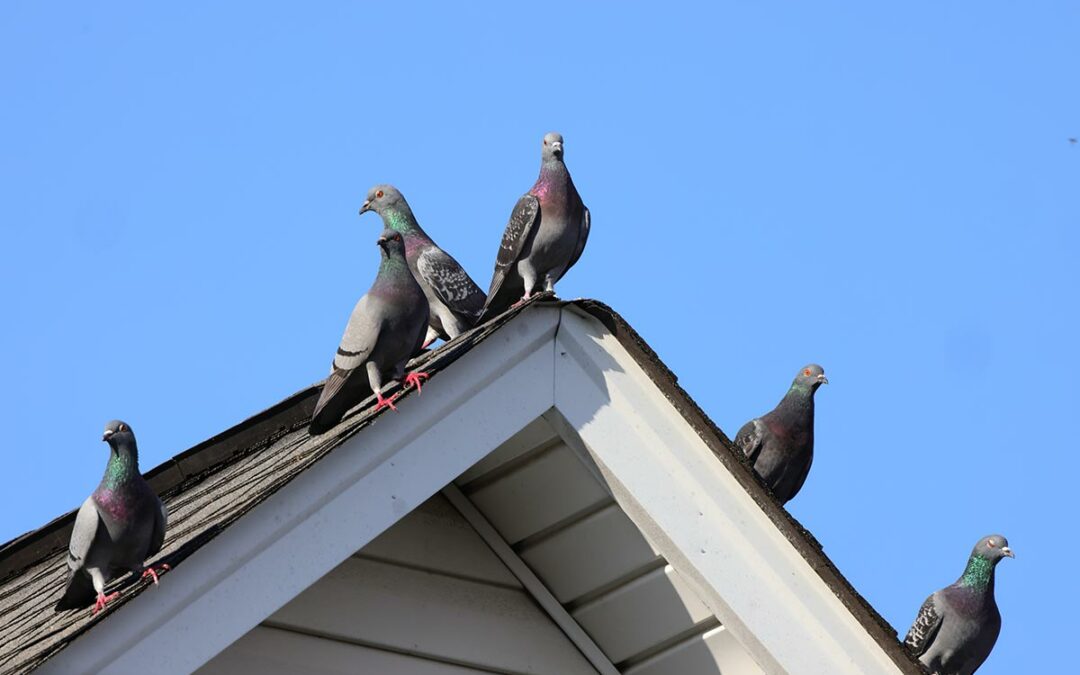
by Pigeon Patrol | Feb 10, 2025 | 4-S Gel Bird repellent, Animal Deterrent Products, Bird Deterrent Products, Bird Netting, Bird Spike, Bird Spikes, pet bird, Pigeon Patrol's Services, Pigeon Spikes, Pigeons, Raccoons, Sparrows, UltraSonic Bird Control
Pigeons may seem harmless at first, but once they take over a property, they can create serious problems. They leave behind acidic droppings, clog drainage systems, spread diseases, and make a lot of noise. If you’re dealing with a pigeon infestation, you’re probably wondering: how do I get rid of pigeons for good?
The good news is that there are humane and effective methods to control pigeons. In this guide, we’ll cover why pigeons are a problem, the best pigeon control solutions, and how to prevent them from returning.
Why Pigeons Are a Problem
1. Pigeon Droppings Cause Property Damage
Pigeon droppings are acidic and can erode stone, concrete, and metal surfaces. Over time, this can cause damage to rooftops, balconies, cars, and historical buildings.
2. Pigeons Spread Diseases
Pigeons carry bacteria, fungi, and parasites that can lead to serious health risks. Some diseases associated with pigeons include:
- Histoplasmosis – A fungal infection that affects the lungs.
- Salmonella – Bacteria that cause food poisoning.
- E. coli – A serious bacterial infection.
3. They Block Drainage and Ventilation Systems
Pigeons often nest in gutters, vents, and chimneys, causing blockages that can lead to water damage and poor air circulation.
4. Pigeon Infestations Hurt Business Image
If pigeons are constantly roosting on your storefront or business sign, it can create a dirty and unprofessional look that turns away customers.
Best Ways to Get Rid of Pigeons
Install Bird Spikes to Prevent Perching
Bird spikes are one of the best pigeon deterrents. They are designed to make it impossible for pigeons to land on ledges, fences, and rooftops.
Use Bird Netting to Keep Pigeons Away from Large Areas
If you need to prevent pigeons from accessing balconies, rooftops, or warehouses, bird netting is a great solution. It creates a physical barrier without harming the birds.
Install Pigeon Repellers (Ultrasonic & Motion Activated)
Ultrasonic pigeon repellers emit high-frequency sounds that humans can’t hear but pigeons find annoying. Motion-activated repellers use light and sound to scare birds away.
Pigeon Trapping for Severe Infestations
For larger infestations, humane pigeon traps may be necessary.
Simple Solutions
- Block Entry Points with Pigeon-Proof Barriers
Pigeons like to nest in vents, chimneys, and eaves. Use wire mesh or netting to block these spaces and prevent pigeons from returning.
- Clean Up Food Sources & Water Availability
Pigeons are drawn to food scraps and water sources. Seal trash bins, clean up outdoor eating areas, and remove standing water to make your property less attractive to pigeons.
Are bird spikes harmful to pigeons?
No, bird spikes do not harm pigeons. They simply prevent them from landing on surfaces.
How long does it take for pigeon deterrents to work?
Most deterrents work immediately after installation. However, pigeons may take a few days to realize the area is no longer suitable for roosting.
Do pigeon repellers work on other birds?
Yes, ultrasonic and motion-activated repellers can deter other pest birds such as crows and seagulls.
Will pigeons eventually stop coming back?
Yes, if you remove food sources, block access points, and use deterrents consistently, pigeons will find another place to roost.
Where can I buy high-quality pigeon deterrents?
You can get bird spikes, netting, and repellers at Pigeon Patrol, a trusted name in pigeon control solutions.
Pigeons can be a major nuisance, but with the right pigeon control solutions, you can protect your home or business. Whether you choose bird spikes, netting, repellers, or a combination of these, taking proactive steps will keep pigeons away for good.
For expert pigeon control products, check out our Pigeon Patrol products and browse our range of humane pigeon deterrents.
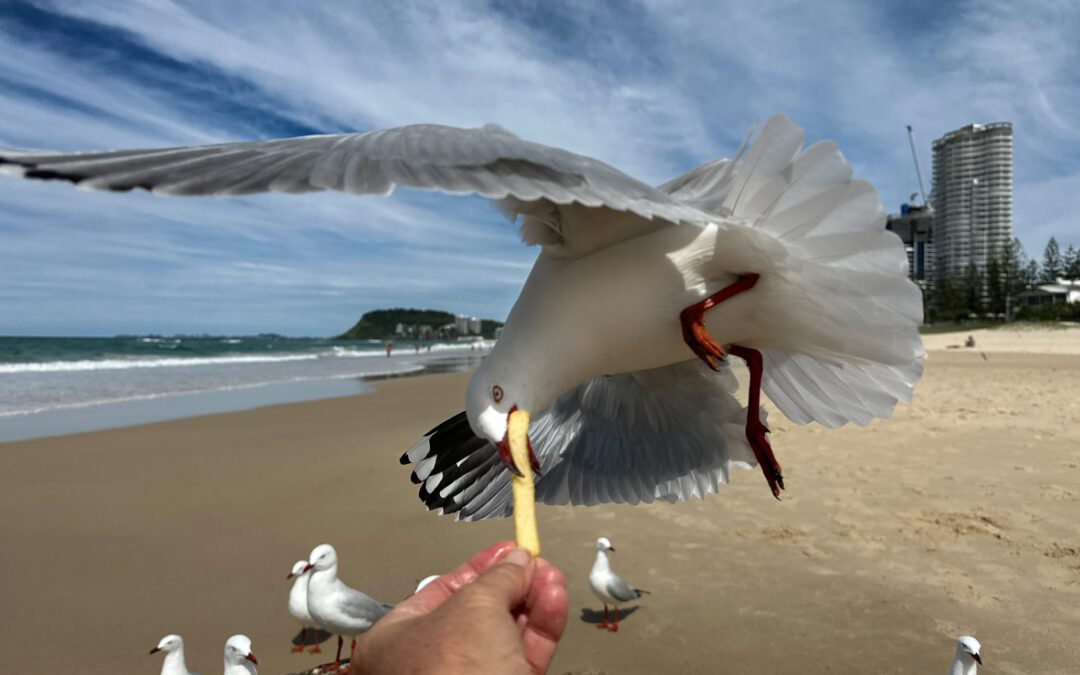
by Pigeon Patrol | Oct 15, 2024 | Bird Deterrent Products, Bird Law, Bird Netting, Bird Spikes, Columbidae
The U.K. considered training pigeons to deliver weapons of mass destruction but changed its mind, government files show.
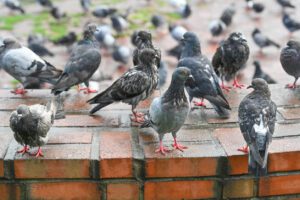
City pigeons
It considered using the birds to deliver biological weapons after World War II but decided the birds had outlived their usefulness in battle.
Homing pigeons carried vital messages in wartime, and the Pigeon Policy Committee of the day discussed training them to undertake ever more daring tasks.
“We can now train pigeons to ‘home’ to any object on the ground when air-released in the vicinity… Bacteria might be delivered accurately to a target by this means,” head of the Air Ministry Pigeon Section Lea Rayner said in a 1945 report.
“With the latest developments of explosives and bacterial science I suggest that this possibility should be closely investigated and watched.
“A thousand pigeons, each with a two ounce explosive capsule, landed at intervals on a specific target might be a seriously inconvenient surprise.”
But other committee members did not share Rayner’s enthusiasm and in 1948 the armed services said they had no further interest in pigeons.
The secret services, however, thought anti-British forces would continue to communicate with each other via pigeons and asked a civilian pigeon fancier to keep 100 birds for MI5 to use to prepare countermeasures.
But they abandoned that scheme in 1950.
The U.K. used about 250,000 pigeons to carry messages in World War II and 32 of the birds received the Dickin Medal, the highest award of valour for animals.
The birds were also used for aerial surveillance. At the beginning of the 20th century Bavaria’s pigeon fleet flew over Europe with cameras attached to their bodies that took a series of timed shots.
Pigeon Patrol Products & Services is the leading manufacturer and distributor of bird deterrent (control) products in Canada. Pigeon Patrol products have solved pest bird problems in industrial, commercial, and residential settings since 2000, by using safe and humane bird deterrents with only bird and animal -friendly solutions. At Pigeon Patrol, we manufacture and offer a variety of bird deterrents, ranging from Ultra-flex Bird Spikes with UV protection, Bird Netting, 4-S Bird Gel and the best Ultrasonic and audible sound devices on the market today.
Canada’s top wholesaler for bird deterrent products for twelve consecutive years.
Contact us at 1- 877– 4– NO-BIRD, (604) 585-9279 or visit our website at https://www.pigeonpatrol.ca/
Bird Gone, Pigeon Gone, Pigeon problems, pigeon spikes, 1-877-4NO-BIRD, 4-S Gel, Bird Control, Pigeon Control, bird repellent, Bird Spikes, sonic bird repellent, stainless steel bird spikes, bird spikes Vancouver, Ultra Sonic Bird Control, Bird Netting, Plastic Bird Spikes, Canada bird spike deterrents, Pigeon Pests, B Gone Pigeon, Pigeon Patrol, pest controller, pest control operator, pest control technician, Pigeon Control Products, humane pigeon spikes, pigeon deterrents, pigeon traps, Pigeon repellents, Sound & Laser Deterrents, wildlife control, raccoon, skunk, squirrel deterrent, De-Fence Spikes, Dragons Den, Pigeon, Pigeon Patrol, Pigeons Roosting, Vancouver Pigeon Control, Bird Spikes, Bird Control, Bird Deterrent, Pigeon Deterrent, Surrey Pigeon Control, Pest, Seagull deterrent Vancouver Pigeon Blog, Birds Inside Home De-fence, Pigeon Nesting, Bird Droppings, Pigeon Dropping, woodpecker control, Keep The Birds Away, Birds/rats, seagull, pigeon, woodpecker, dove, sparrow, pidgeon control, pidgeon problem, pidgeon control, flying rats, pigeon Problems, bird netting, bird gel, bird spray, bird nails, bird guard, Pigeon control, Bird deterrents, Pigeon deterrents, Bird control, solutions, Pigeon prevention, Pigeon repellent, Bird proofing, Pest bird management, Pigeon spikes, Bird netting, Humane bird control, Bird exclusion, Urban bird control, Anti-roosting devices, Pigeon removal, Bird barriers
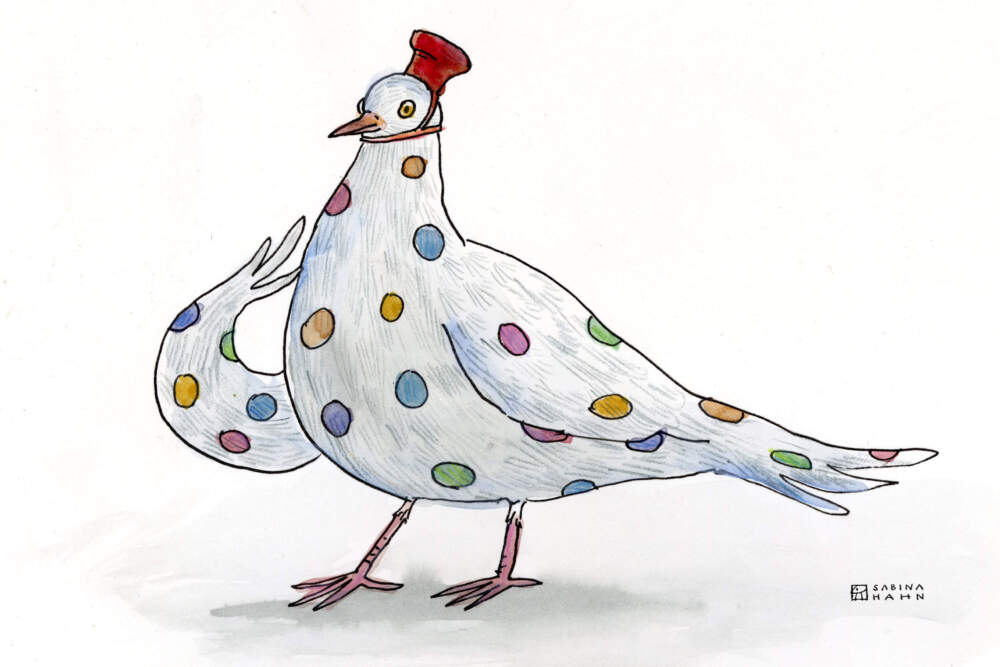
by Pigeon Patrol | Oct 15, 2024 | Animal Deterrent Products, Bird Deterrent Products, Bird Law, Bird Netting, Bird Spikes
Mayor of London Ken Livingstone was unexpectedly “ruffled” on his trip to the US, by protesters opposed to his plan to reduce the number of pigeons in Trafalgar Square.
He was on a fact-finding mission to the US, but had not expected to be doused in water over an issue related to London’s most famous square.Mr Livingstone has been criticised after refusing to renew the licence of the last bird feed vendor in Trafalgar Square. Andrew Butler, a spokesman for the pressure group People for the Ethical Treatment of Animals (PETA) told how activists doused Mr Livingstone with a pitcher of water during a news conference in Washington DC on Thursday.
A protester shouted: “Your plan to poison pigeons is all wet. Mayor Livingstone starves pigeons to death.”
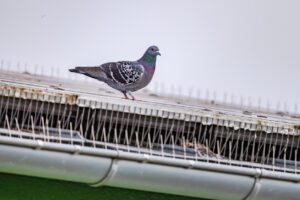
Pigeon on a roof with solar panels with pigeon spikes to repel pigeons, Darmstadt, Germany
Bird feed seller Bernard Rayner has until Friday to give up his job, after which the Greater London Authority will implement a one-month phased withdrawal of feed from the capital’s famous landmark.Mr Rayner had traded on a temporary licence since October after a High Court appeal against an earlier move by Mr Livingstone to target the pigeons.
At that time, Labour MP Tony Banks tabled a Commons’ motion in a bid to save the “gentle London pigeon”. Mr Butler said that people in the UK may be surprised about the trans-Atlantic interest shown in the issue – but the US activists feel strongly about the fate of the birds. He said: “This isn’t Hawaii. It’s freezing-cold concrete-covered London. There are no luscious fruit trees for the birds to flit over to. The baby and elderly pigeons have nowhere else to seek food.
“They’ll starve. What’s he going to introduce next? Bear-baiting? He is waging war against the symbol of peace. Pigeons are rock doves, and Ken needs to extend an olive branch.” The GLA plans to clean up the mess caused by pigeon droppings and pedestrianise the upper part of the square to make way for more cultural pursuits for visitors.
But Dr Jayne Cuthbert, a research fellow at Kingston University who has advised the government on pigeons, confirmed PETA’s fears that withdrawing the food supply will result in the deaths of thousands of the birds.
She said: “The basic law of ecology is that there will only be as many birds in any area as there is enough food to feed them. “The Trafalgar Square pigeons will therefore not be able to fly off elsewhere because there will be no food available.” The number of pigeons in British towns and cities is estimated to have doubled in the past five years.
Mr Livingstone spent the earlier part of the week in New York to find out about its public transport and urban regeneration schemes. He is now spending two days in Washington as a guest at the annual conference of US mayors
Pigeon Patrol Products & Services is the leading manufacturer and distributor of bird deterrent (control) products in Canada. Pigeon Patrol products have solved pest bird problems in industrial, commercial, and residential settings since 2000, by using safe and humane bird deterrents with only bird and animal -friendly solutions. At Pigeon Patrol, we manufacture and offer a variety of bird deterrents, ranging from Ultra-flex Bird Spikes with UV protection, Bird Netting, 4-S Bird Gel and the best Ultrasonic and audible sound devices on the market today.
Canada’s top wholesaler for bird deterrent products for twelve consecutive years.
Contact us at 1- 877– 4– NO-BIRD, (604) 585-9279 or visit our website at https://www.pigeonpatrol.ca/
Bird Gone, Pigeon Gone, Pigeon problems, pigeon spikes, 1-877-4NO-BIRD, 4-S Gel, Bird Control, Pigeon Control, bird repellent, Bird Spikes, sonic bird repellent, stainless steel bird spikes, bird spikes Vancouver, Ultra Sonic Bird Control, Bird Netting, Plastic Bird Spikes, Canada bird spike deterrents, Pigeon Pests, B Gone Pigeon, Pigeon Patrol, pest controller, pest control operator, pest control technician, Pigeon Control Products, humane pigeon spikes, pigeon deterrents, pigeon traps, Pigeon repellents, Sound & Laser Deterrents, wildlife control, raccoon, skunk, squirrel deterrent, De-Fence Spikes, Dragons Den, Pigeon, Pigeon Patrol, Pigeons Roosting, Vancouver Pigeon Control, Bird Spikes, Bird Control, Bird Deterrent, Pigeon Deterrent, Surrey Pigeon Control, Pest, Seagull deterrent Vancouver Pigeon Blog, Birds Inside Home De-fence, Pigeon Nesting, Bird Droppings, Pigeon Dropping, woodpecker control, Keep The Birds Away, Birds/rats, seagull, pigeon, woodpecker, dove, sparrow, pidgeon control, pidgeon problem, pidgeon control, flying rats, pigeon Problems, bird netting, bird gel, bird spray, bird nails, bird guard, Pigeon control, Bird deterrents, Pigeon deterrents, Bird control, solutions, Pigeon prevention, Pigeon repellent, Bird proofing, Pest bird management, Pigeon spikes, Bird netting, Humane bird control, Bird exclusion, Urban bird control, Anti-roosting devices, Pigeon removal, Bird barriers
